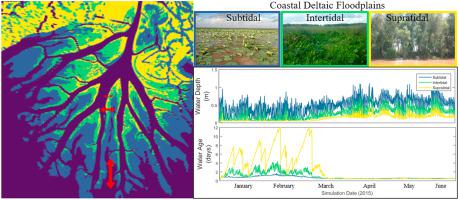Estuarine, Coastal and Shelf Science ( IF 2.6 ) Pub Date : 2020-09-06 , DOI: 10.1016/j.ecss.2020.106995 Alexandra Christensen , Robert R. Twilley , Clinton S. Willson , Edward Castañeda-Moya

|
Located at the mouth of large rivers, coastal deltaic floodplains are important ecosystems for trapping sediment and removing excess nitrogen introduced to the river through agricultural and urban runoff. Hydrological connectivity (the percent of river channel water interacting with floodplain wetlands), water age (the time elapsed since water entered the system via the main river channel) and water temperature have strong impacts on the biogeochemical processes controlling the fate of sediment and nutrients at continental margins. A Delft3D hydrodynamic model was used to explore the role of river and tide forcings, hydrogeomorphology, and vegetation roughness on hydrological connectivity, water age, and water temperature of a young, prograding river delta in coastal Louisiana, Wax Lake Delta. Across a simulation period of January to June 2015, an average of 39.9% of river flow entered the delta floodplains and water within the floodplains had an average water age of 0.8 days. In winter and spring, floodplain zones with higher sediment surface elevations (supratidal hydrogeomorphic zones) were characterized by increased water age and warmer water temperatures compared to subtidal floodplains and channels. Our experimental models indicate that the presence of wetland vegetation decreases hydrological connectivity by preventing flow of water into deltaic floodplain, but increases water age by retaining water within the floodplains. Despite small amplitudes (~30 cm), tides create hourly exchange between channels and floodplains, which decreases water age in floodplains, but has little impact on average connectivity. Our results emphasize the role of both hydrological forcings (river and tides) and ecosystem features (vegetation and sediment surface elevation) in regulating channel-floodplain interactions in deltaic systems. Evaluated against field data, which is often difficult to collect at high spatial and temporal frequency in floodplains, this model performs well, highlighting the utility of numerical models in capturing landscape-scale hydrodynamics.
中文翻译:

模拟密西西比河三角洲沿海三角洲泛滥平原内的水文连通性和水龄
沿海三角洲泛滥平原位于大河口,是重要的生态系统,可用于捕获沉积物并清除通过农业和城市径流引入河中的过量氮。水文连通性(河道水与洪泛区湿地相互作用的百分比),水年龄(自水通过主要河道进入系统以来经过的时间)和水温对控制沉积物和养分命运的生物地球化学过程有强烈影响。大陆边缘。Delft3D水动力模型用于研究河流和潮汐强迫,水文地貌和植被粗糙度对路易斯安那州Wax Lake Delta海岸中一个正在发育的年轻三角洲的水文连通性,水年龄和水温的作用。在1月到2015年6月的模拟期间,平均39.9%的河流量进入三角洲洪泛区,洪泛区内的水平均水龄为0.8天。在冬季和春季,与潮下洪泛区和河道相比,具有较高沉积物表面高度的洪泛区(水上地貌区)的特征是水龄增加,水温升高。我们的实验模型表明,湿地植被的存在通过阻止水流入三角洲洪泛区而降低了水文连通性,但通过将水保留在洪泛区中而延长了水龄。尽管幅度很小(约30厘米),潮汐却在河道与洪泛区之间形成每小时的交换,这减少了洪泛区的水龄,但对平均连通性影响很小。我们的结果强调了水文强迫(河流和潮汐)和生态系统特征(植被和沉积物表面高程)在调节三角洲系统中河床与平原之间的相互作用中的作用。根据田间数据(通常很难在洪泛区中以高时空频率收集)进行评估,该模型表现良好,突出了数值模型在捕获景观尺度水动力方面的实用性。











































 京公网安备 11010802027423号
京公网安备 11010802027423号